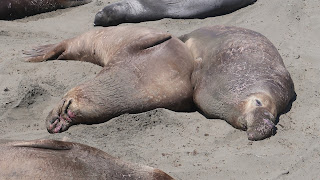December begins the elephant seal breeding season. Adults and pups are active. The first pup was born overnight on December 15-16, in the rain.
Pups are born on the sand
Seeing a pup born is exciting. Watch for females
fussing and tossing a lot of sand. They sometimes toss so much, they build a
sort of perch for themselves, with deep ditches dug out on both sides.
Ask a Friends of the Elephant Seal guide. They may be
able to direct you to a mother ready to have her pup. Look for the crowd.
Everyone is eager to see newborn pups.
Pups are often a surprise – just when you’re watching
one mother, another down the beach squirts out her pup. That’s wildlife.
Be patient. The seals are on their own timetable.
Pregnant females will continue to arrive on the beach through February. Most
births happen in January, and are more likely to occur at night.
Pups can be born anywhere on the beach, throughout the
rookery, from the lighthouse to Arroyo Laguna.
Pups are all black, about three feet long and weight
about 70 pounds when they’re born. They soon plump up on their mothers’
nourishing milk. They’ll nurse for a month. In the last few days of nursing, the
mothers mate with one or more males. They wean the pups abruptly when they
return to the ocean.
Beachmasters are vigilant
Dominance dictates the social organization on the
beach. A beachmaster will defend a harem of 20 or 30 females and their pups. The
beachmaster needs to be vigilant, because less dominant bulls will constantly
attempt to sneak into the harem of females, or make a direct challenge to him.
Subdominant, beta, bulls hang around the edges. The alpha bull tolerates some
peripheral bulls, who help maintain the perimeter from other bulls.
Watch seals from a distance
Bulls that lose out find their way to other local
beaches, sometimes called bachelor beaches. I don’t agree with calling them
“loser beaches.” Only 1 percent of male elephant seal pups survive to prime
breeding age of 12 or 13 years. Any seal that shows up is a winner in the
survival sweepstakes.
Hearst Memorial Beach at San Simeon Cove attracts them.
Human beach visitors may be surprised by a seal among the driftwood.
FES will post guides there for the duration, through
March, to advise visitors as to seals they may encounter.
The seals are not aggressive toward humans, but the
bulls that come to San Simeon are tired and may be injured from losing their
battles with other bulls. They may challenge other bulls to fight on the beach.
Human visitors stay safe by giving the seals a wide berth. NOAA Marine LifeViewing Guidelines advise no closer than 50 yards, half a football field. Keep the dog leashed so
as not to annoy them. Don’t get between two seals, who may decide to charge
each other, or a seal and the water, in case he suddenly decides to go back
into the waves.
Informed beach visitors can coexist with the seals.
The Piedras Blancas rookery is an example of seals and humans sharing the
beach. Stay safe and give the seals time to rest.


.JPG)


.JPG)










.JPG)



.JPG)





.JPG)

.JPG)
.JPG)
.JPG)









